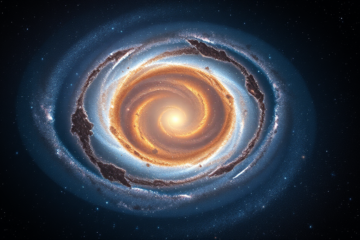First Observation of Planetary Formation at HOPS-315
Planetary formation is a fascinating and complex topic that has intrigued scientists for decades.
In this article, we will explore the recent discovery made by the ALMA and James Webb telescopes, which provided the first direct observation of the birth of a planetary system outside our Solar System.
We will focus on the young star HOPS-315, located approximately 1,300 light-years from Earth, and the dynamics of its protoplanetary disk, where grains of rocky material are beginning to form.
This research brings new understanding to how Earth-like planets can develop in distant star systems.
Unprecedented observation of the birth of a planetary system
Astronomy took a revolutionary step with the incredible discovery of the first direct observation of the birth of a planetary system outside the Solar System.
Using the powerful ALMA and James Webb telescopes, scientists were able to capture the formation of the young star HOPS-315, located an impressive 1,300 light-years away in the constellation Orion and less than 100,000 years old.
This achievement marks a significant advance in understanding the processes involved in the formation of planetary systems, similar to what occurred in our own Solar System.
Structure of the protoplanetary disk and early rock grains
In the heart of the protoplanetary disk from HOPS-315, particles of dust and gas begin a cosmic dance, colliding and merging through the processes of increase It is coalescence.
This interaction is fundamental for the formation of rocky grains initials, which lay the foundation for future Earth-like planets.
During this process, the tiny grains aggregate, forming solid clumps that continue to grow over time.
Observations from ALMA and James Webb allow us to understand this complexity where each collision and merger shapes the future of this planetary system.
This knowledge is essential to understand the formation of planets, similar to what occurred in our Solar System.
Gas cooling and crystal solidification
The presence of silicon monoxide It is silicate crystals in the protoplanetary disk of HOPS-315 is relevant to prove the cooling and solidification of the gas around the star.
These compounds play fundamental roles in this process, allowing the formation of Earth-like planets to begin.
Silicon monoxide acts as a highly efficient radiator, dispersing heat and aiding in the transition from the gaseous to the solid state.
At the same time, silicate crystals serve as nuclei for the aggregation of solid material, facilitating the creation of planetary bodies.
This evidence in the protoplanetary disk indicates a process analogous to what occurred in our early Solar System.
This gives scientists the chance to directly observe the genesis of a planetary system, using powerful astronomical tools such as the ALMA telescope and the James Webb Telescope.
| Compound | Function in cooling |
|---|---|
| Silicon monoxide | Efficient radiator that disperses heat |
| Silicate crystals | Cores for aggregation of solid material |
This observation remembers the primordial formation of our Solar System, narrowing the relationship between current discoveries and our already established astronomical knowledge.
For more information about this advancement, visit the article on Protoplanetary Disks on the Astronomer's Portal.
Parallels with the early Solar System
Studies of planetary formation in HOPS-315
They illuminate our understanding of events in the early Solar System.
We observe that the initial steps, such as cooling and solidification of the protoplanetary disk, are similar to what occurred 4.6 billion years ago around the Sun.
This phenomenon includes the emergence of rocky materials from dust grains and the presence of silicate crystals, suggesting the beginning of solidification.
In HOPS-315, we effectively distinguish:
- Dust accretion process
- Similarities in the cooling of the gas around the young star
The observed parallels reinforce theories of the genesis of terrestrial planets in primordial cosmic space.
Research perspectives on planetary formation
The discovery of a planetary system forming around the young star HOPS-315 brings new perspectives to astronomy.
Researchers plan to use advanced telescopes like ALMA and James Webb to observe other young stars, identifying similar signs of planetary formation.
This will allow a broader understanding of the origin of planetary systems.
Analysis of the protoplanetary disks of these stars will reveal enriching information about the process of dust grain aggregation, comparable to what occurred in our Early Solar System.
The identification of compounds such as silicon monoxide and silicate crystals will serve as indicators of the beginning of the solidification of the hot gas around the stars.
Directly observe this crucial moment of planetary formation will significantly expand our knowledge.
Furthermore, future studies will have the following main objectives:
- Mapping disks on class 0 stars
- Identify essential chemical elements in planetary formation
.
Exploring these possibilities will not only enrich our understanding of astrophysics, but also will influence the search for Earth-like planets.
Using advanced technologies, scientists will be able to deepen your analysis, offering an increasingly detailed view of the cosmic processes that shape the universe.
In summary, the observations of HOPS-315 mark a significant milestone in the understanding of planetary formation and encourage us to explore new stars for similar processes.
The future of astrophysics promises important discoveries about the origin of planetary systems.



0 Comments